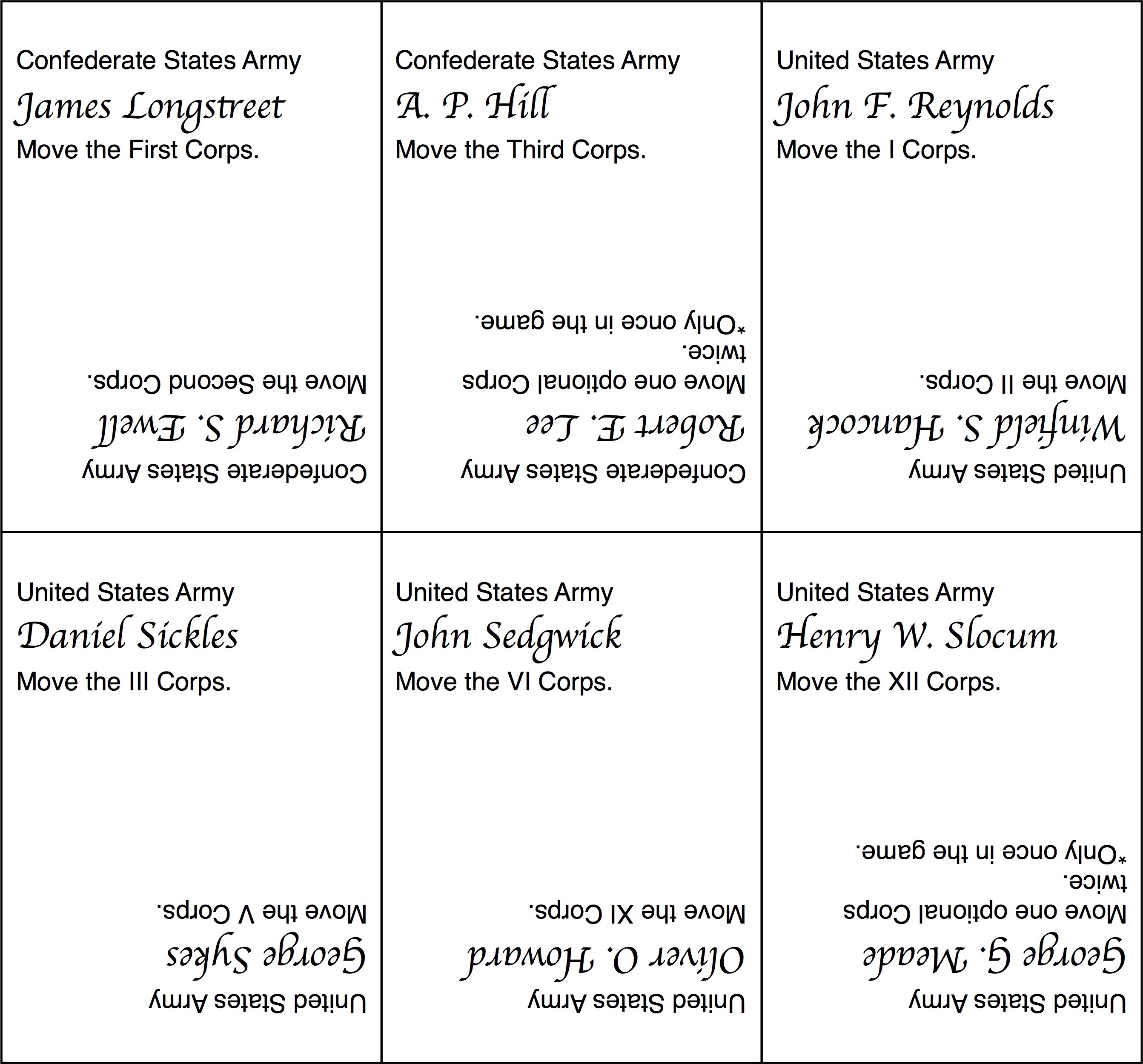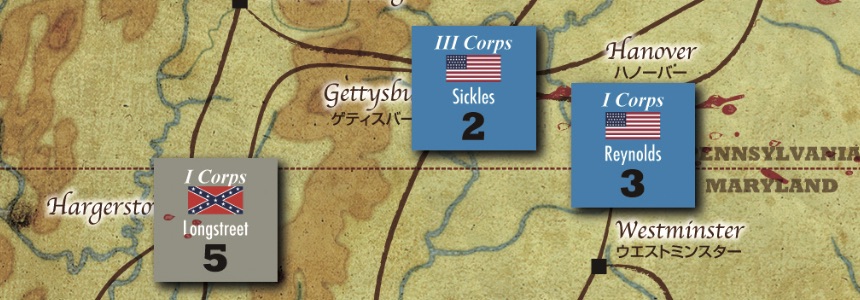Mini-Game (Postcard Game) "Gettysburg Campaign" †
This is English rules of "Gettysburg Campaign", a free postcard game presented by Command Magazine Japan Edition (CMJ) in 2013. Original webpage is here.
1. INTRODUCTION †
"Gettysburg Campaign" is a game dealing with the Battle of Gettysburg on the campaign level. It's a two-player game, one takes charge of the Confederate Army, another one the Union Army.
2. COMPONENTS †
Please cut off counters yourself. And 6 cards are also used. In addition, please prepare 6-sided dice.
To a person who does not have the game (map, counters and cards):
Please download the game from the following, print it, and use it.
Map and counters download (9.24MB)
Cards

3. GAME SETUP †
Put all of 3 Confederate units on Fredericksburg, all of 7 Union units on Washington, D.C. Put the "Turn" marker on "1" of the Turn Record Track. Both players receive cards (2 for the Confederate Army, 4 for the Union Army).
4. VICTORY CONDITIONS †
If the Confederate Army gains 6 points by the end of Turn 9, the Confederate Army wins; otherwise the Union Army wins. If a Confederate unit enter into a town, the Confederate Army gains the point of the town. Each town provides the points only once. Even if the Union Army regains the town, the Confederate's points are not lost. Moreover, if a unit is eliminated, it does not become the points.
5. GAME SEQUENCE †
The game progresses by repeating "Turn". One Turn consists of the following procedures:
- Command Phase
- Initiative Judgement Phase
- Initiative Player Movement Phase
- Non-initiative Player Movement Phase
- Combat Phase
Procedure 1 to 4 mentioned above is called "round". At least one round is performed in one Turn, but according to the result of the judgement of the initiative, the Movement Phases might not be performed or more than one round is performed. However, regardless of the number of the rounds, the Combat Phase is performed only once per Turn.
6. COMMANDS †
In the Command Phase, the Union player chooses two of four cards and places them face-down in front, the Confederate player chooses one of two cards and places it face-down in front. At this time, the cards have the difference between the upper side and the lower side. The player gives a command to the upper side corps commander. Please take care of the side. Corps which took a command may move during the friendly Movement Phase. Robert E. Lee and George G. Meade may be used only once in the game.
Corps which cannot take a command: Giving a command to a Corps which is going to move to a town placed an enemy unit is not allowed. And giving a command to a Corps in a town approached by an enemy unit is not allowed.
Commands must be given as far as there is a Corps which may take a command. If both sides have no Corps which may take a command, the Movement Phase ends and the Combat Phase begins, regardless of the result of the judgement of the initiative.
7. INITIATIVE JUDGMENT †
After both sides gave a command, both players roll a die to judge the initiative. A player which rolled a higher die has the initiative. In case of a tie, the round ends immediately (commands are not executed) and the Combat Phase begins.
Lee and Meade: Robert E. Lee and George G. Meade may be used only once in the game. If these cards are chosen and the judgement of the initiative results a tie, these cards are considered to be unused and return to each player's hand. And it is not necessary to tell the identity of unused cards to the opponent.
8. MOVEMENT †
In the friendly Movement Phase, the player opens command cards and moves commanded Corps to an adjacent town connected by a road. A Corps, which is commanded by Lee or Meade, may move twice. Movement is optional, but if a Corps is commanded by Lee or Meade and does not move, the card is considered to be used and becomes unusable after that.
After the Non-initiative Player Movement Phase, the Command Phase starts again, but if both sides move no Corps in one round, the Combat Phase is performed and the Turn ends.
In case there is an enemy Corps in the town where a friendly Corps moved to: The enemy player must decide immediately whether to vacate the town or to defend the town. If vacating, move the Corps to an adjacent town. At this time, moving to a town containing an enemy Corps is not allowed. In addition, moving to the town where the enemy Corps came from is not allowed either. If defending, place the Corps in the middle of movement on the road to indicate that it is advancing on the town which the enemy defends. A Corps advancing on a town must fight against the enemy in the town in the Combat Phase.
If a non-initiative player's unit is decided to vacate or defend, it cannot move in the round even if it is commanded.
If the player decides to defend the town, overturning the decision is not allowed even if additional enemy Corps moves to the town.
Example of movement: The Confederate Army command the First Corps and the Union Army command the I Corps and the III Corps in a round. The Confederate player seizes the initiative by the initiative judgement. The Confederate player moves the First Corps to Gettysburg. The Union player must decide whether to retreat the III Corps or to defend Gettysburg. If retreating, the III Corps moves to an adjacent town (moving to Hagerstown, where the First Corps came from, is not allowed) and cannot move no more in the round. The Union player decided to defend Gettysburg. The Confederate Army's First Corps is placed on the road between Hagerstown and Gettysburg to indicate that it is advancing on Gettysburg. After this, the Confederate player cannot command the First Corps and the Union player cannot command the III corps either. In the Non-initiative Player Movement Phase, the Union player moves the I Corps to Gettysburg.
If the judgement of the initiative results a tie in the next round, the round ends immediately and the Confederate Army's First Corps becomes an offense and fights against the Union Army's I Corps and III Corps in Gettysburg in the Combat Phase.
9. COMBAT †
Each combat occurs between a Corps advancing on a town and an enemy Corps in the town. A Corps advancing on a town is called attacker, a Corps in the town defender. Combat is resolved at each town. In case combats occur in more than one town in one Combat Phase, the Confederate player decides the order of towns resolved combat. Each combat is resolved by performing the following procedures:
1) Defender's firing: The defender totals up Combat Strength of Corps in the town. The defender gives the attacker one hit every five Combat Strength. If there is a fraction, roll a die the same times as the fraction. The defender gives the attacker one more hit each time rolling a "6". For example, if the sum total of Combat Strength is 7, the defender gives the attacker one hit, rolls two dice and gives one more hit each time rolling a 6.
2) Attacker's firing: The attacker totals up Combat Strength of Corps advancing on the town. If multiple Corps are advancing on the same town via multiple road, they are considered to attack simultaneously. In case of an attack from one road, the attacker gives the defender one hit every five Combat Strength. In case of an attack from two roads, the attacker gives the defender one hit every four Combat Strength. In case of an attack from three roads, the attacker gives the defender one hit every three Combat Strength. If there is a fraction, roll a die the same times as the fraction. The attacker gives the defender one more hit each time rolling a "6". For example, if the Confederate Army's three Corps (13 Combat Strength) attack the Union Army at Gettysburg from Carlisle, Chambersburg and Hagerstown, the Confederate Army give four hits, roll a die and give one more hit if rolling a 6. If the three Corps attack from Carlisle, the Confederate Army give two hits, roll three dice and give one more hit each time rolling a 6.
3) Comparison between hits: Compare both hits on the enemy. If it is a tie or the defender is one more than the attacker, the attack fails and the attacker must return to the town of the starting point. If there is an enemy unit in the town of the starting point, the attacker cannot retreat and the unit is removed. If the attacker is one more than the defender, the defender retreats. The defender retreats into an adjacent town. Retreating into a town containing an enemy unit is not allowed. In addition, retreating via a road containing an attacker's Corps is not allowed either. A unit which cannot retreat is removed. If there are multiple ways of retreat, the attacker may choose the way of retreat. In case multiple units retreat, it does not matter whether they retreat together or separately. In case giving two or more hits than the enemy, remove one enemy Corps and retreat surviving Corps in the way mentioned above. A player who took the hit decides which unit is removed.
Optional rules of firing: The players may roll a die the same times as Combat Strength instead of automatically giving one hit at regular Combat Strength, but the upper limit of rollable dice in one combat is five. In case of 7 Combat Strength, the player may choose zero automatic hit + rolling five dice over one automatic hit + rolling two dice. In case of 13 Combat Strength via three roads, the player may choose four automatic hits + rolling one die or three automatic hits + rolling four dice or two automatic hits + rolling five dice. In case of 13 Combat Strength via one road, the player may choose two automatic hits + rolling three dice or one automatic hit + rolling five dice. The defender fires first; therefore the attacker may decide whether to use this option or not after checking the result of the defender's firing.
10. TURN END †
After the Combat Phase ends, one Turn ends. Advance the Turn marker one step. According to both side's movement and the result of the judgement of the initiative, the Combat Phase might end without a combat.
After the Combat Phase of Turn 9 ends, the game ends. Check victory conditions and decide victory or defeat.
#ウォーゲーム #TRPG #TCG #ボードゲーム #ボドゲ 月イチ恒例、アジアの卓上ウォーゲーム事情の直近1ヶ月分をまとめた「亜州卓上戦棋定点観測」を更新。ビリビリ動画は92件。https://t.co/w3bKeq3VGR
— 田村寛 (@tamurahiroshi14) July 1, 2025
